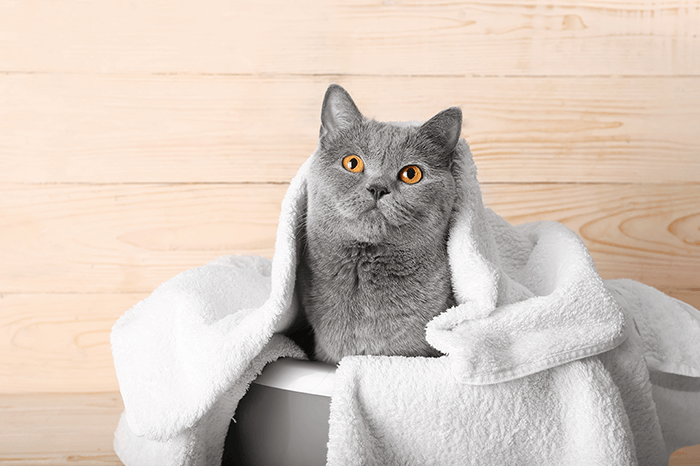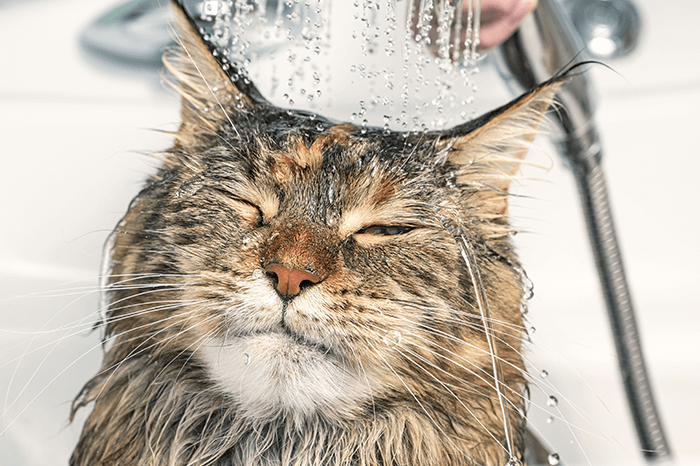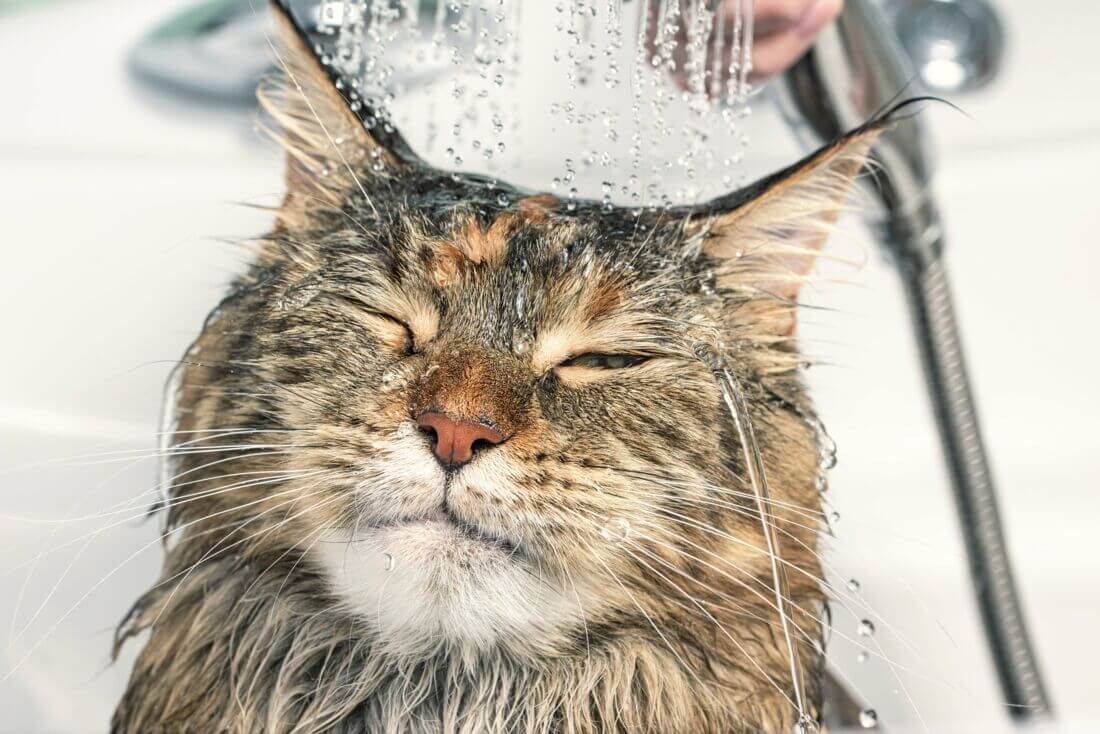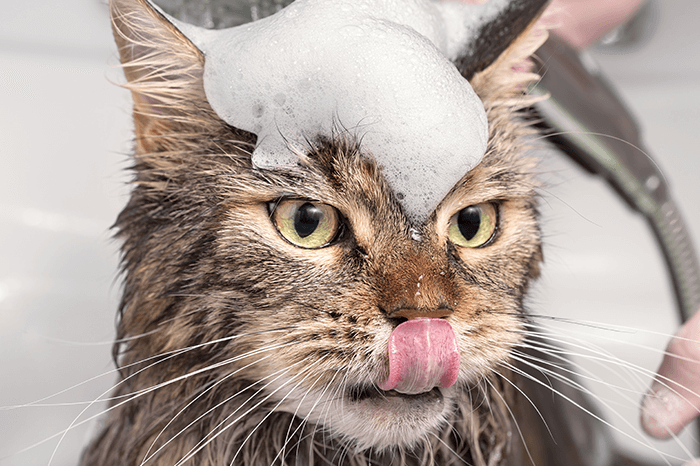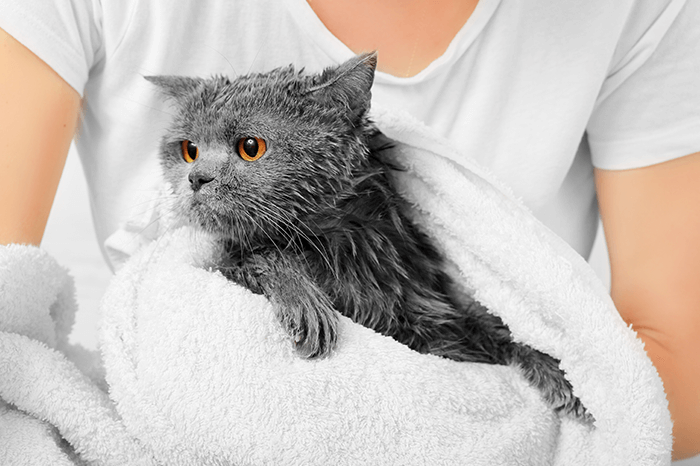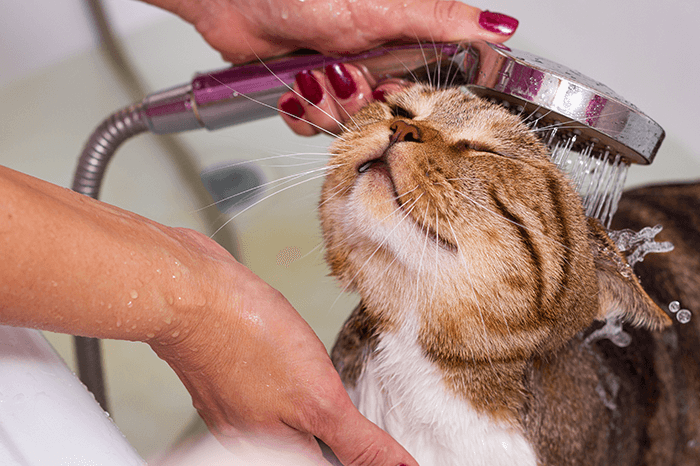Bathing your cat : why, how and when ?
Marina G VeterinarianCats usually don’t need to be bathed. But in some situations it is necessary. It can be a daunting prospect! But with the right help, it can much more feasible.
Cats are often to be found grooming themselves, fastidiously cleaning every inch of fur and skin. Grooming is a highly innate natural behaviour for cats, and in most cases will be sufficient to keep them clean. So, should you bathe your cat? In most cases, no need to do so. However, there are certain circumstances when bathing your cat might be recommended, and this can be a daunting prospect! Cats and water are not known to be the best of friends, so here are some tips as to the whys, the whens and the hows of cat baths!
When should you bathe your cat?
Most cats can manage to remove most dirt and dust by themselves, or with a little help from their owners brushing or combing them. However, there are some scenarios where only a bath will do the job.
Outdoor cats
Outdoor cats will occasionally roll in something disgustingly smelly, which you may want to remove as soon as you can, and a brush may not do a full enough job! If your cat frequents roads with parked cars, oil and grease can drip onto their coats. This can be difficult to remove with grooming, and is not advisable for the cat to ingest, so is best removed by bathing.
Older cats
Some older cats, or those with certain medical problems that restrict movement, can find it difficult to perform a full-body groom. If their coat is not well attended to, it can become matted and dirty. This is especially common around the back end. This will become uncomfortable and can lead to skin problems. If your cat is struggling to groom themselves, speak to your vet, as there are some medical causes such as arthritis that can contribute to this. Cats who don’t look after their own grooming will need help from their owners, which may involve bathing as well as grooming.
Skin conditions
Certain skin conditions in cats may need topical treatment onto the affected area with a medicated shampoo. Some cats will tolerate this, others might find it more difficult. There are some tips further along in this article or speak to your vet if this is proving too difficult.
Owner allergies
Owning a cat when you have allergies can be a difficult balance. Recent studies have shown that regular bathing of cats does reduce the amount of allergen they shed, but the bathing must be regular to make a difference to the environmental levels. This is only appropriate if your cat tolerates baths well. If bathing your cat regularly, use a shampoo such as the DOUXO® S3 CARE line to prevent their skin from drying out.
What should you use to bathe your cat?
A pet-specific shampoo is best, such as DOUXO® S3 CARE Shampoo. Baby shampoos are actually not recommended as the pH of baby skin is very different from cat skin. Always check the instructions for how much to use. Warm water, rather than hot or cold, is best. Read our article dedicated to this topic.
Does your cat need a full bath?
It depends. If your cat is covered in something noxious, they may need a full immersive bath. However, if you are just trying to remove a patch of oil, or they have a small area of skin that needs treating with a medicated shampoo, then you may be able to reduce the stress by skipping the bath. Instead, thoroughly wet the area, apply the shampoo as directed and then rinse. Some cats will find washing an area of skin or fur more acceptable and less stressful than a full bath, so it is worth considering. Spot baths can also be useful if you need to bathe your cat regularly, such as to manage a skin condition, as full baths too often can dry the skin.
How do you actually bathe your cat?
Well, this is the big money question. If your cat needs a full bath, then here are some top tips on how to bathe your cat:
- You can use a normal bath, or a small tub, with a non-slip mat
- Fill with warm water, but not very deep. Cats tend to panic in deep water as they are not natural swimmers! Aim to have the water reach the top of their legs.
- Use a jug to gently pour water over your cat until they are thoroughly wet
- Cats are sensitive with water around their faces: don’t pour water around this area, but use a cloth or flannel to wet the area
- Put the required amount of shampoo on your hands and then rub all over. Some pet shampoos don’t lather well, so don’t use more than the directed amount if no lather forms, just gently rub the product in.
- If you need to wash the face, be careful to avoid the eyes and mouth
- Some medicated shampoos need to be left on for a certain amount of time before being rinsed off, so check the instructions before the bath
- Use fresh warm water in a jug, or a very gentle setting on the shower head to rinse the shampoo away.
- Dry using a towel, if tolerated. Hairdryers are usually too noisy, so a gentle rub with a towel is best
- Let your cat rest in a warm room. They will want to groom themselves, so make sure the shampoo is completely rinsed away. Let them have some quiet time to settle themselves down, as most cats will find bathing somewhat stressful.
What do you do if your cat REALLY hates water?
Outdoor cats who have got dirty can usually be helped with a very thorough brushing with a fine-tooth comb. This can also be used for those cats who struggle to groom themselves. Most dirt and grime will come away with a good brushing, as will matted fur, but this may take some time and patience.
It is a good idea to accustom your cat to being groomed by you, so that they tolerate it well when needed. It is also an excellent way to bond with your cat, and to keep a close eye on their coat and skin. Start by very short sessions of gentle brushing, alongside some treats so that your cat associates grooming with a positive experience. Gradually build up the length of the sessions and keep at it regularly so that your cat becomes used to it.
If they really need a bath but are getting very stressed at the experience, try and start slowly. Use a small tub rather than a normal bath, hold the cat close to your body (you might get wet too!) and use very small amounts of water. Spot baths can be useful if your cat is very fearful, even if you have to do a few small spot baths over a period of time rather than one full bath.
When is bathing a cat NOT necessary?
Most cats don’t need regular or routine bathing. Their grooming should be enough to maintain good skin hygiene and coat condition. Even older cats who may need help with grooming will often just need brushing rather than a full bath.
Flea shampoos are still available in some pet shops and supermarkets but are quite ineffective – and a very stressful way to rid your cat of parasites! Speak to your vet about more effective ways to remove unwanted ‘friends’.
